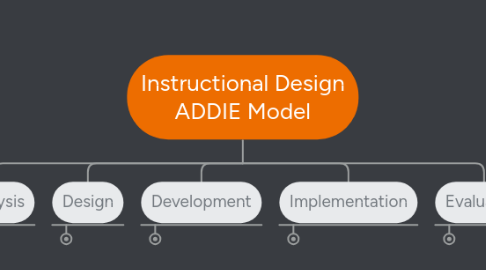
1. Analysis
1.1. Learner Analysis (through the year)
1.1.1. Interests
1.1.2. Background Knowledge
1.1.3. Attitude about topic/subject
1.1.4. Interpersonal relationships/skills
1.2. Context/Resource
1.2.1. Technology
1.2.2. Money
1.2.3. Staff
1.2.4. Community/Parental Involvement
1.2.5. Curriculum Materials
1.2.6. Physical Space
1.2.7. Students
1.3. Content/Task/Work
1.3.1. Self-assessment on topic
1.3.2. Standards
1.3.3. Research
1.3.4. District Requirements
1.3.5. Curricular Materials
1.3.6. What Matters?
1.3.6.1. Choose topics
1.3.6.2. Combine like topics
1.3.6.3. Decide on an ordering
2. Design
2.1. Understanding by Design (UbD)
2.1.1. Essential Questions
2.1.1.1. Used to define concept-based big ideas
2.1.1.2. Used to set direction for a unit
2.1.1.3. Used to create depth rather than breadth
2.1.1.4. Used to increase interaction and retention of material
2.1.1.5. Unique structures
2.1.1.5.1. How does [noun] [direct verb] [noun]? Why does [noun] [direct verb] [noun]?
2.1.2. Enduring Understandings - two or more concepts combine to make a relationship
2.1.2.1. Meant to be generalization, not specific
2.1.2.1.1. DO NOT USE proper nouns, personal nouns, past tense, past perfect tense, present perfect tense
2.2. Universal Design for Learning
2.2.1. Provide Multiple Means of Representation
2.2.1.1. Options for Perception - multiple displays of information
2.2.1.2. Options for Language, Mathematical Expressions, and Symbols - explaining notation, clarifying vocabulary
2.2.1.3. Options for Comprehension - use background knowledge, highlight big ideas, visualization
2.2.2. Provide Multiple Means of Action and Expression
2.2.2.1. Options for Physical Action - vary methods of response, assistive technologies
2.2.2.2. Options for Expression and Communication - multiple media, tools for composition
2.2.2.3. Options for Executive Functions - guide goal-setting, support planning, manage info
2.2.3. Provide Multiple Means of Engagement
2.2.3.1. Options for Recruiting Interest - individual choice, relevance, minimize distractions
2.2.3.2. Options for Sustaining Effort and Persistence - goals and objectives, collaboration, mastery-oriented feedback
2.2.3.3. Options for Self-Regulation - high expectations, teach coping skills and strategies, self-assessment and reflection
2.2.4. Assistive Technology
2.3. Differentiation
2.3.1. Content
2.3.1.1. Different elements and materials
2.3.1.2. Tasks and objectives aligned to learning goals
2.3.1.3. Concept-focused, principle-driven lessons
2.3.2. Process
2.3.2.1. Practice flexible grouping
2.3.2.2. Classroom Management is key!
2.3.3. Product
2.3.3.1. Always assessing student readiness and growth
2.3.3.2. Vary expectations and requirements for student responses
2.4. Writing Objectives
2.4.1. ABCD
2.4.1.1. Audience - Specify who the objective is being written for
2.4.1.2. Behavior - Describe the specific behavior that is expected from the student
2.4.1.3. Condition - Describe the conditions under which the student is operating
2.4.1.4. Degree - Specify how well the student has to perform
2.4.2. Terminal and Enabling Objectives
2.4.2.1. Terminal - what students will know or be able to do at the end of the unit/lesson
2.4.2.2. Enabling - the component skills and knowledge that enable the learner to reach the terminal objective
2.4.3. Types of Objectives
2.4.3.1. Cognitive - thinking skills
2.4.3.1.1. Knowledge
2.4.3.1.2. Comprehension
2.4.3.1.3. Application
2.4.3.1.4. Analysis
2.4.3.1.5. Synthesis
2.4.3.1.6. Evaluation
2.4.3.2. Affective - emotional skills
2.4.3.2.1. Receiving - willing to listen
2.4.3.2.2. Responding - willing to participate
2.4.3.2.3. Valuing - willing to be involved
2.4.3.2.4. Organizing - willing to be an advocate
2.4.3.2.5. Characterization - willing to change one's way of life
2.4.3.3. Psychomotor - physical skills
2.4.3.3.1. Action - elementary movement
2.4.3.3.2. Coordination - synchronized movement
2.4.3.3.3. Formation - bodily movement
2.4.3.3.4. Production - combine verbal and nonverbal movement
2.4.3.4. Interpersonal - working with others
2.4.3.4.1. Seeking - asking for information
2.4.3.4.2. Proposing Ideas - suggesting
2.4.3.4.3. Building and Supporting - active listening, constructive feedback
2.4.3.4.4. Disagreeing - voicing a contradictory opinion
2.4.3.4.5. Summarizing - synthesizing ideas
2.5. SMCM Lesson Plan Template
3. Implementation
3.1. Apply your lesson plan in the classroom!
4. Evaluation
4.1. Formative Assessments
4.1.1. Questions should: Be short, clear, and focused Be easily classified by research objectives Not be loaded/biased Include all possible answers Not be open-ended Consider audience
4.2. Summative Assessments
4.3. Technology for Evaluation Examples
4.3.1. Turning Point
4.3.2. Socrative
4.3.3. Google Forms
4.3.4. SMART Response
5. Development
5.1. Gagne's Events of Instruction
5.1.1. Gain Attention - Rouse the learner's interest
5.1.2. Inform Learners of Objectives - Tell them objectives/List agenda
5.1.3. Stimulate Recall of Prior Learning - Connect current lesson to previous ideas
5.1.4. Present the Content - Convey info in chart, diagram, multimedia, etc.
5.1.5. Provide Guidance - Give cheat sheets, tips, additional references that will help the student learn new material
5.1.6. Elicit Performance - Let students practice with discussion, quizzes, etc.
5.1.7. Provide Feedback - Let students know how they are doing
5.1.8. Assess Performance - Evaluate whether training was effective
5.1.9. Enhance Retention and Transfer - Allow students to apply what they have learned

